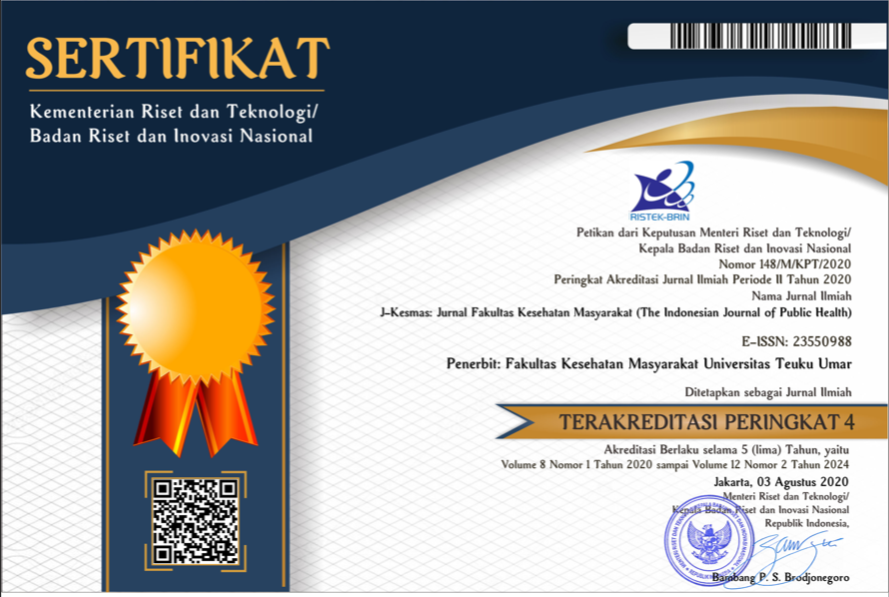The Effectiveness of Homemade Soymilk in Increasing Haemoglobin (Hb) Levels in Pregnant Women
Abstract
The high prevalence of anaemia in pregnant women in West Aceh Regency (40.5%), which is indicated by the haemoglobin (Hb) levels of below 11 g%, should receive special attention because anaemia will have an impact on maternal and infant mortality. Soy milk is one processed beverage that contains iron, high protein, essential fatty acids, fibre, vitamins and minerals. Nutrients contained in soy can produce energy, maintain optimal body functions, and meet the needs of iron in pregnant women. Soybean is a type of food which is ranked third to have the richest iron (8.8 mg%) after meat and cereals. The purpose of this study was to examine the effectiveness of homemade soy milk in increasing Hb levels in pregnant women. The study design was an experiment on pregnant women. The object of this study was pregnant women in their first and second trimester of pregnancy. The intervention was giving homemade soy milk by adding 10 ml of honey, as a substitute for sugar, to 1 cup of homemade soy milk (250 ml), from a basic intake of 4 mg of iron per day for pregnant women. This intervention resulted in a significant increase in Hb levels in pregnant women (P < 0.005). The provision of homemade soy milk can significantly increase the mean of Hb levels in pregnant women with an average increase of 2.99 mg% ± 1.422. Furthermore, the p-value obtained was = 0.000, indicating that there was a significant difference in Hb levels between measurement I (before being given homemade soy milk) and after being given homemade soy milk for 3 months. Homemade soy milk is an effective drink in increasing Hb levels in pregnant women.
Keywords
Full Text:
PDFReferences
Advances in Nutrition. Iron 1. Am Soc Nutr Adv Nutr [Internet]. 2012;3:(1):532–3. Available from: http://eds.b.ebscohost.com.ezproxy.endeavour.edu.au/eds/pdfviewer/pdfviewer?vid=25&sid=d7c1ae22-bf65-4e2f-b282-807977ba9940%40sessionmgr115&hid=117
Astuti R., Aminah S., & Syamsianah A. (2014). Komposisi Zat Gizi Tempe Yang Difortifikasi Zat Besi Dan Vitamin A Pada Tempe Mentah Dan Matang (Nutritional Composition of Soyben Tempeh Fortified with Iron and Vitamin A on Uncook and Cook Soyben Tempeh). Agritech. 34(2), 151–9.
Budimarwant, C. (2017). Komposisi dan nutrisi pada susu kedelai. Compotition Nutrition, 1–7.
Chakrabarti S., Kishore A., Raghunathan K., & Scott SP. (2019). Impact of subsidized fortified wheat on anaemia in pregnant Indian women. Maternal Child Nutrition, 15(1), 1–11.
Utomo, G. (2012). Pengaruh Pemberian Nutrisi Kedelai Terhadap Peningkatan Kadar Hemoglobin Tikus Strain Wista Anemia. Journal of Chemical Information and Modeling.
Yang Z, & Huffman SL. (2011). Review of fortified food and beverage products for pregnant and lactating women and their impact on nutritional status. Maternal Child Nutrition, 7(3), 19–43.
WHO. (2015). Comprehensive implementation plan on maternal, infant and young child nutrition.
DOI: https://doi.org/10.35308/j-kesmas.v6i2.1159
Refbacks
- There are currently no refbacks.
Managed by Fakultas Kesehatan Masyarakat
Published by Universitas Teuku Umar
Website: http://jurnal.utu.ac.id/jkesmas
Email: jkemas@utu.ac.id 
This work is licensed under a Creative Commons Attribution-ShareAlike 4.0 International License.







.jpg)


